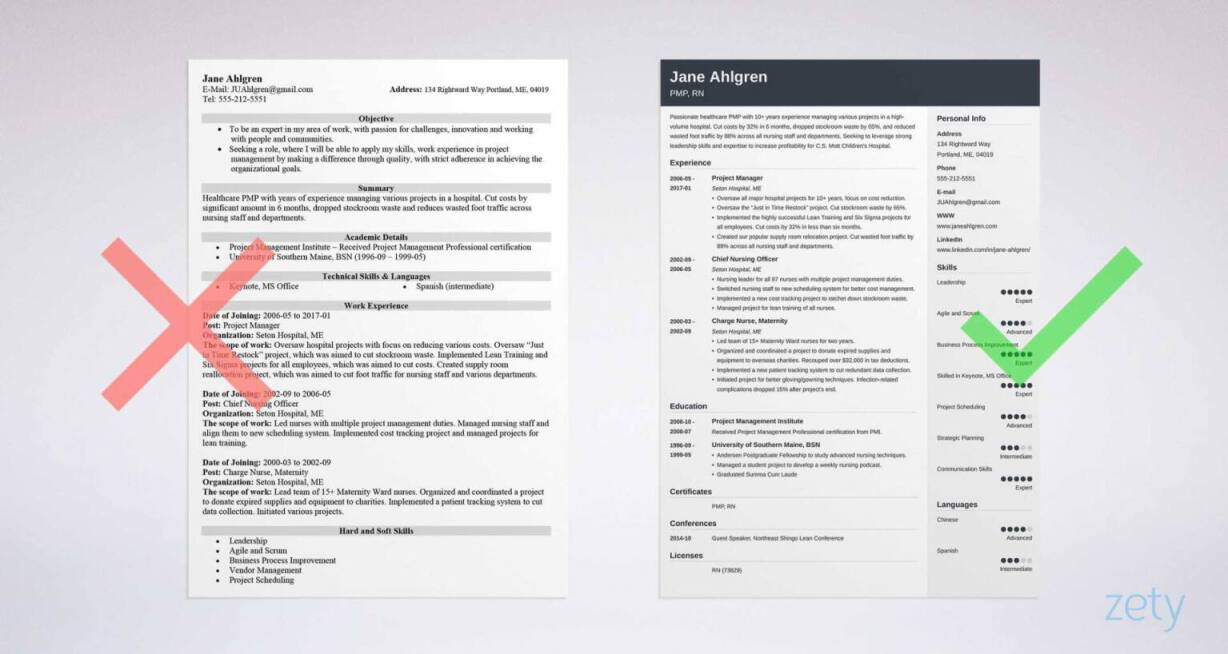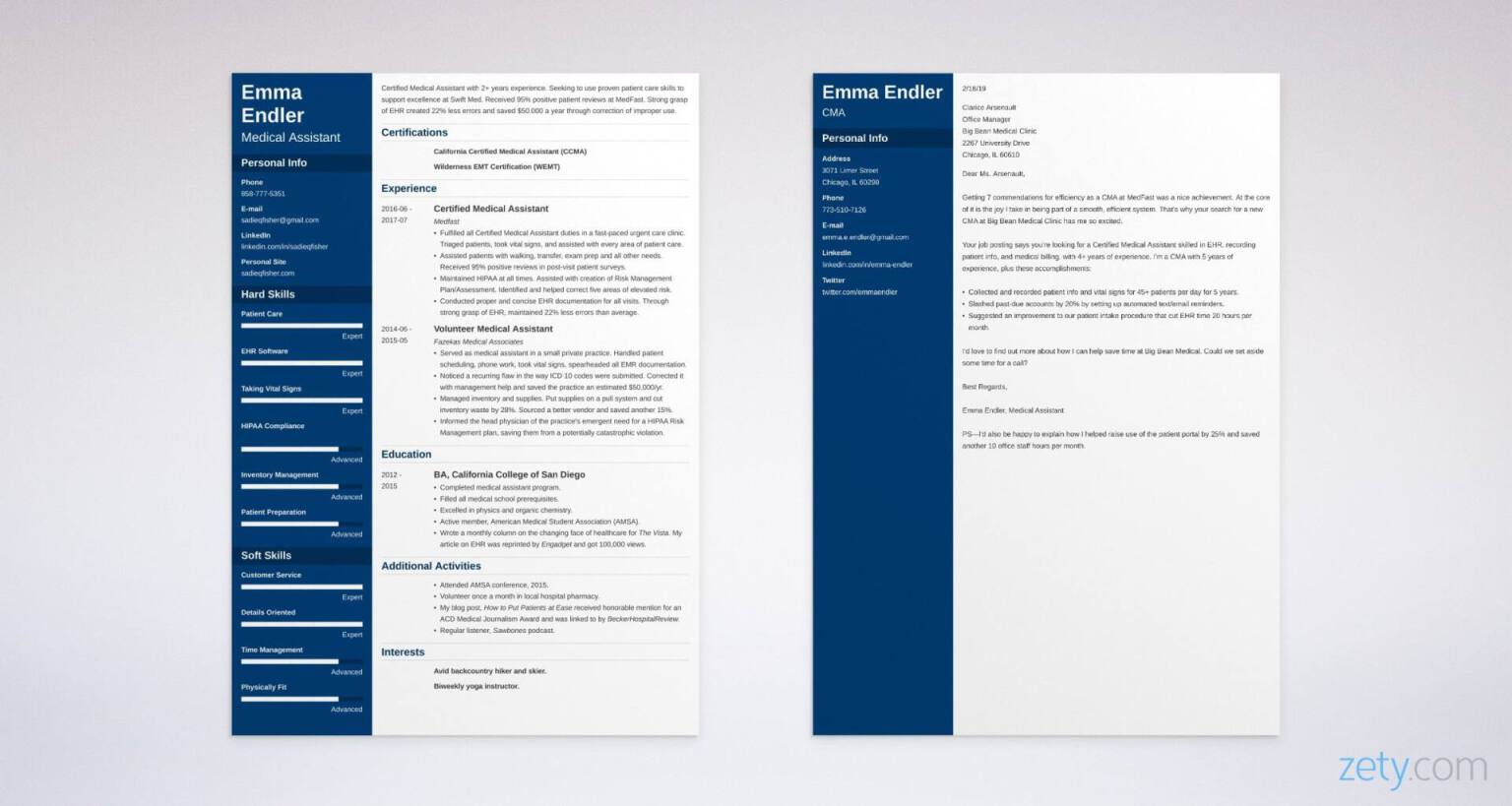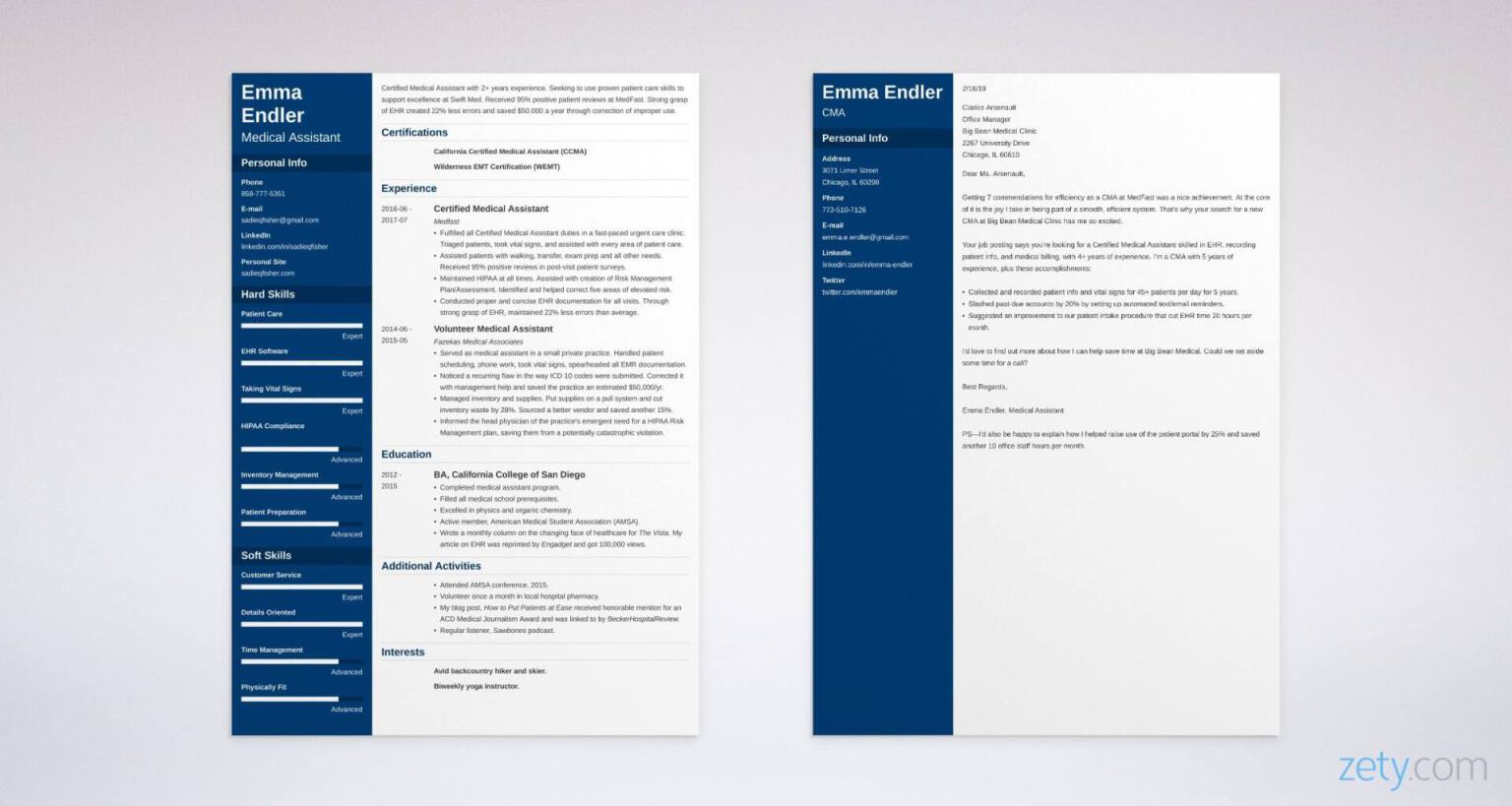What's the Difference Between a Cover Letter vs a Resume?
Create your cover letter nowWhat's the difference between a cover letter and a resume? Knowing the answer to this question is the foundation of a successful job search. In this guide, I'll clear up any doubts you may have regarding the resume vs. cover letter topic.
This guide will show you:
- The difference between a resume and cover letter and their definitions.
- What the purposes of a resume and cover letter are.
- How cover letters and resumes complement each other.
- Why neither of the two should be confused with a CV.
Want to write your cover letter fast? Use our cover letter builder. Choose from 20+ professional cover letter templates that match your resume. See actionable examples and get expert tips along the way.
Sample cover letter for a resume—See more cover letter samples and create your cover letter here.
1. What Is a Resume?
A resume is a formal summary of your work experience, education, and skills, divided into sections. It shows your career history in a structured way and provides the recruiter with crucial information about your professional background. It’s usually one or two pages long, and should be targeted to a specific job opening.
What should a resume include?
Look at the list below:
- Contact information
- Career summary or career objective
- Work experience section
- Education section
- Skills
- Extra resume sections (courses, publications, certificates, conferences, languages, etc.)
The goal of a resume is to present you as a job candidate in an itemized, short, and informative way. All resume sections have to be labelled with clear and professional headings.
As a whole, the document should follow the rules of a chosen resume format (usually the reverse-chronological one) and stick to the resume length standards. Your resume must be easy to scan, as studies show that recruiters spend just 7 seconds initially skimming a resume.
Read this guide to learn how to write a resume that sells better than Amazon: How to Make a Resume for a Job.
Or, cut to the chase and find a resume for your profession here: 99+ Resume Examples for Every Profession.
Want to save time and have your resume ready in 5 minutes? Try our resume builder. It’s fast and easy to use. Plus, you’ll get ready-made content to add with one click. See 20+ resume templates and create your resume here.

Sample resume made with our builder—See 18+ templates for a resume here.
Now, what is a cover letter for a resume?
Let’s check.
2. What is a Cover Letter?
A cover letter is a business letter that you send to a prospective employer to introduce yourself as a candidate. It provides additional professional information about you explains to the recruiter why you’re applying for the position. Resume cover pages should not repeat the contents of resumes. Their goal is to supplement them.
What should a cover letter include?
- Professional cover letter heading
- Proper cover letter address section
- Proper salutation
- Compelling cover letter introduction
- Reasons you chose to apply to this company
- Your offer and a strong closing statement
- Optionally, a postscript to hook their attention once more
Just like resumes, cover letters follow specific formatting rules and have their own length limitations.
Here’s how to tell your story in a cover letter: How to Write a Job-Winning Cover Letter.
Also, look up examples for your profession in our collection of Professional Cover Letter Examples.
Want to write your cover letter fast? Use our cover letter builder. Choose from 20+ professional cover letter templates that match your resume. See actionable examples and get expert tips along the way.

Sample Cover Letter for a Resume—See more cover letter templates and create your cover letter here.
3. Cover Letter vs. Resume vs. CV—The Differences
There are three types of differences between cover letters and resumes:
Cover Letters and Resumes Have a Different Purpose
To get the difference between a cover letter and a resume, you need to understand the functions they have:
- Resume summarizes your work history and qualifications. It gives the hiring manager an overview of your “professional self.”
- Cover letter sells your qualifications. It’s supposed to provide the recruiter with the answers to why and how questions (Why do you want to work for this company and no other? How can you contribute?)
Cover Letters and Resumes Have a Different Format
Resumes and cover letters have different formats and formatting rules:
- A resume is a document divided into specific sections. It shows information in the form of bullet points.
- A cover letter consists of 3 or 4 paragraphs of text, divided into an opening, body, and closing. You can also add a “PS” line below your signature at the bottom.
Cover Letters and Resumes Have a Different Tone
Resumes are more formal in tone than cover letters. That’s why we always recommend writing resumes in the third person. Instead of writing “I managed a group of 20 people,” we suggest you opt for “managed a group of 20 people.”
A cover letter is your own professional story written in the first person. Hence, using “I” in a cover letter is recommended and expected.
Why is that so?
Before your resume is read by the recruiter, it’s scanned by the Applicant Tracking Systems (ATS). Cover letters are explicitly meant for human (not machine) readers.
Also:
- Resumes are objective; cover letters—subjective.
- Resumes use a professional tone; cover letters are more conversational. Telling the recruiter who you are, what passions you have, and how you can help the company give your entire application a more personal touch.
Now you know the difference between a resume and a cover letter.
But wait a minute—
There are also CVs. And there’s a lot of confusion about them.
CV vs. Resume vs. Cover Letter
A CV (or Curriculum Vitae, from Latin) is the equivalent of a resume in Europe—and globally, in Academia. However, in each of these contexts, CVs follow different formats. Read more about CV formats in Europe here and compare them with academic CVs here.
What’s the problem?
People tend to confuse cover letters with CVs. The truth is Europeans often use the terms resume and CV interchangeably, so if you're applying for a job in Europe and are asked for a CV, it means you should submit a resume not a cover letter.
For more in-depth CV and resume comparison, check out our dedicated guide: CV vs. Resume: Difference and Definitions.
4. How Resumes and Cover Letters Complement Each Other
Now that you know the difference between a cover letter and a resume (and a CV), let’s see how they work side by side.
Simply put—
Your resume is an outline for your cover letter story.
In your resume, you list the critical aspects of your professional experience. In a cover letter, you describe them.
Cover letters complement resumes.
They give candidates a chance to elaborate on the basics that the resume covers and explain things only mentioned there.
So, treat your cover letter as a chance to tell the recruiter something more about yourself and reiterate your value as a candidate. Did you know that a 2023 JobVite report has shown that 53% of hiring managers are stressed at work? And 45% of them are stressed because there are not enough qualified candidates out there. That's why by writing a killer cover letter, you can highlight why you're exactly who they're looking for and make their lives just a little bit easier.
Prepare your resume first. Then, to write a great cover letter, ask yourself:
- Why did you apply to this company?
- What is your motivation to work with them?
- How can your work experience and professional skills contribute to the company’s needs?
- Do you share similar values?
There’s another reason you need both documents.
As a Career Expert at Zety.com, Bart Turczynski says:
A cover letter is a brief and to-the-point pitch. It is supposed to make the recruiter or hiring manager read your resume. In real life, however, the resume often determines whether the cover letter is read.
A cover letter is a brief and to-the-point pitch. It is supposed to make the recruiter or hiring manager read your resume. In real life, however, the resume often determines whether the cover letter is read.
Pro Tip: When writing your resume and cover letter always double-check your grammar and spelling. Regardless of the document type, errors look unprofessional and can cost you an interview.
Some say cover letters are a waste of time. Is it really the case? Check out: Are Cover Letters Necessary?
We evaluated 11 million resumes created using our builder and found that these are the top 10 professions that often include a cover letter:
- Business Operation Specialists
- Top Executives
- Advertising, Marketing, and PR Managers
- Clerks
- Engineers
- Retail & Sales Representatives
- Healthcare Practitioners
- Financial Specialists
- Teachers and Instructors
- Counselors, social workers, and social service specialists
Key Takeaway
Let's sum up the differences between a cover letter and a resume:
- A resume is factual and brief. Think of it as a list of your professional skills and experience. A cover letter, on the other hand, is more detailed. It lets you tell employers why you’re the best person for the job. Your cover letter enhances your resume by adding color and personality.
- Resumes list qualifications—cover letters describe them.
- A resume is a formalized document; a cover letter has a more personal touch.
- Cover letters complement resumes and are still expected by most hiring managers.
Do you have any other questions about resume and cover letter differences? How would you define a resume and a cover letter? If you still have doubts, let us know in the comments.
About Zety’s Editorial Process
This article has been reviewed by our editorial team to make sure it follows Zety's editorial guidelines. We’re committed to sharing our expertise and giving you trustworthy career advice tailored to your needs. High-quality content is what brings over 40 million readers to our site every year. But we don't stop there. Our team conducts original research to understand the job market better, and we pride ourselves on being quoted by top universities and prime media outlets from around the world.

